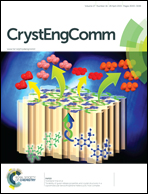Fabricating roughened surfaces on halloysite nanotubes via alkali etching for deposition of high-efficiency Pt nanocatalysts
Abstract
Technological applications of heterogeneous nanocatalysts on supports have generally relied on the surface or interface properties of supports. Herein, we report a facile approach to fabricate roughened surfaces on halloysite nanotubes (HNTs) through etching the wall of HNTs in a molten-salt system. SEM, TEM, XRD, FTIR, AFM and N2 adsorption/desorption analysis are employed to systematically investigate the morphology, structure and surface properties. The results suggest that the roughness of HNTs surface has been significantly increased and defects are formed on the tube wall without structural damage. Subsequently, the roughened halloysite nanotubes (RHNTs) are used as supports to prepare heterogeneous nanocatalyst. Pt nanoparticles with a uniform size can be homogeneously deposited onto the RHNTs surfaces via a one-step hydrothermal reduction. The as-prepared Pt@RHNTs catalyst exhibits remarkably improved activity and selectivity for the hydrogenation of cinnamaldehyde towards cinnamyl alcohol compared with the pristine halloysite support. Furthermore, Pt@RHNTs catalyst shows rapid catalytic rates in hydrogenation reactions and excellent leaching resistance in cycle uses.


 Please wait while we load your content...
Please wait while we load your content...